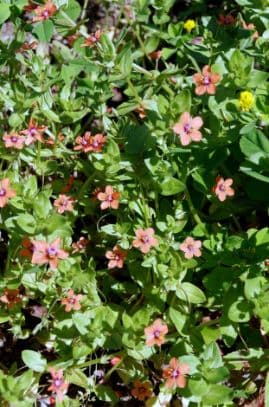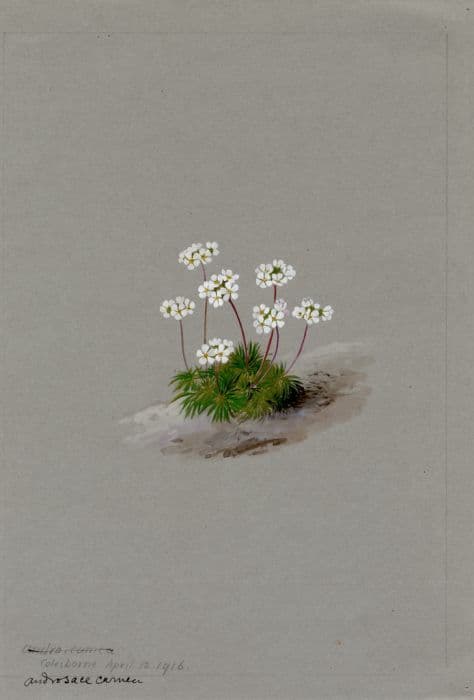Auricula 'Rachel Kinnen' Primula 'Rachel Kinnen' (Au)

ABOUT
'Rachel Kinnen' is an evergreen, perennial, hybrid cultivar, up to 15cm tall, with rosettes of small, pale green leaves. Clusters of lilac flowers with white eyes are produced on short stems from early to late spring
About this plant
 Names
NamesFamily
Primulaceae
Synonyms
Rachel's Primrose, Auricula Primrose
Common names
Primula 'Rachel Kinnen' (Au)
 Characteristics
CharacteristicsLife cycle
Perennials
Foliage type
Evergreen
Color of leaves
Green
Flower color
Pink
Height
6 inches (15 cm)
Spread
6 inches (15 cm)
Plant type
Herb
Hardiness zones
5
Native area
Asia
Benefits
 General Benefits
General Benefits- Aesthetic Appeal: Adds vibrant colors to gardens with its beautiful blooms.
- Attracts Pollinators: Brings bees, butterflies, and other beneficial insects to the garden, aiding in pollination.
- Easy to Grow: Known for being a low-maintenance plant that is easy to care for.
- Seasonal Interest: Provides early spring flowers when few other plants are in bloom.
- Compact Size: Suitable for small gardens, borders, and containers due to its manageable size.
- Variety: Offers a range of colors, providing options for different garden designs and preferences.
- Cold Hardy: Can withstand cooler temperatures, making it suitable for a variety of climates.
- Versatile: Can be used in rock gardens, woodland plantings, and as an underplanting for larger shrubs.
 Medical Properties
Medical PropertiesThis plant is not used for medical purposes.
 Air-purifying Qualities
Air-purifying QualitiesThis plant is not specifically known for air purifying qualities.
 Other Uses
Other Uses- Photography Subject: Primroses, with their bright and attractive flowers, are often used by photographers to practice macro photography techniques or as subjects for botanical illustrations.
- Education: Primroses can be used in educational settings to teach children about plant biology, life cycles, and the importance of biodiversity in gardening.
- Artistic Inspiration: Artists may use the vibrant colors and delicate shapes of primroses as inspiration for paintings, drawings, and other forms of visual art.
- Flower Pressing: Primroses are suitable for flower pressing, a craft used to preserve the beauty of flowers for making bookmarks, cards, and other decorative items.
- Culinary Garnish: The flowers of primroses can be used for garnishing desserts and salads, adding a touch of elegance and color.
- Natural Dyes: The petals of primroses can be used to create natural dyes for coloring fabrics or other materials in crafting projects.
- Eco-friendly Confetti: Dried primrose petals can serve as a biodegradable alternative to traditional confetti at weddings and celebrations.
- Fairy Gardens: Primroses can be incorporated into fairy garden designs to create a whimsical, miniature landscape that captures the imagination.
- Themed Gardens: They can be used in themed garden displays, such as 'storybook gardens' or to represent specific color schemes in landscape design.
- Seasonal Decorations: Live or dried primroses can be included in springtime floral arrangements and decorations for Easter and other spring festivals.
Interesting Facts
 Feng Shui
Feng ShuiPrimula is not used in Feng Shui practice.
 Zodiac Sign Compitability
Zodiac Sign CompitabilityPrimula is not used in astrology practice.
 Plant Symbolism
Plant Symbolism- Youthful Charm: Primula, commonly known as Primrose, often symbolizes the essence of youth and the joy that comes with early spring.
- Hope: As one of the first flowers to bloom in spring, the Primrose represents hope and the renewal that follows the cold dormancy of winter.
- Affection: Gifting Primroses is traditionally seen as a way to express care and affection, signifying that you can't live without the recipient.
- Protection: In folklore, Primroses are thought to protect against evil and were often planted around homes for this purpose.
- Love and Romance: With its delicate and attractive blooms, the Primrose is also associated with aspects of love and the romantic ideal of everlasting affection.
 Water
WaterPrimroses, including the Primula 'Rachel Kinnen', prefer consistently moist soil, so you should water them when the top inch of soil feels dry to the touch. Depending on the environmental conditions, this can mean watering approximately once a week, but this frequency can vary due to factors such as temperature and humidity. Use room-temperature water, and gently water the soil directly, avoiding the leaves to minimize the risk of fungal diseases. Ensure that the pot has good drainage to prevent waterlogging. Each watering session should provide enough water to moisten the soil throughout the pot, which might be around 16 to 24 ounces for a standard-sized plant.
 Light
LightPrimula 'Rachel Kinnen', commonly known as primrose, thrives best in partial shade conditions where direct sunlight is limited. An ideal spot for these primroses would be in an area that receives filtered sunlight or morning sun with afternoon shade. Avoid placing them in full, harsh sunlight as this can lead to leaf scorch and stress the plant.
 Temperature
TemperaturePrimroses, like the Primula 'Rachel Kinnen', prefer cool to moderate temperatures with a range of 50 to 70 degrees Fahrenheit being ideal. They can tolerate temperatures as low as 20 degrees Fahrenheit for short periods, but extended exposure to temperatures below this can be harmful. Similarly, temperatures above 80 degrees Fahrenheit can stress the plant and should be avoided.
 Pruning
PruningPrimroses, including the Primula 'Rachel Kinnen', should be pruned to remove dead or faded flowers to encourage continuous blooming and to maintain a tidy appearance. After the main blooming period in the spring, cut back the spent flower stems to the base of the plant. Additionally, prune away any dead or yellowing leaves at any time to keep the plant healthy. The best time for major pruning is immediately after the plant has finished its main flowering cycle.
 Cleaning
CleaningAs needed
 Soil
SoilThe best soil mix for the Primula, commonly known as the English Primrose, is well-draining, humus-rich, and moisture-retentive. An ideal mixture would be equal parts of loamy garden soil, peat moss or coconut coir, and perlite or sand to improve drainage. Maintain a soil pH between 6.0 and 7.0 for optimal growth.
 Repotting
RepottingEnglish Primrose should generally be repotted every 1-2 years to refresh the soil and accommodate root growth. Spring is the best time to repot to minimize stress and encourage robust growth throughout the growing season.
 Humidity & Misting
Humidity & MistingEnglish Primrose prefers a moderately high humidity environment. Aim for humidity levels of around 50-60% for the best results. This plant will thrive in a naturally humid outdoor environment or in a well-maintained indoor setting with increased air moisture.
 Suitable locations
Suitable locationsIndoor
Place in bright, indirect light and maintain high humidity.
Outdoor
Plant in partial shade, sheltered from wind and extreme heat.
Hardiness zone
4-8 USDA
 Life cycle
Life cyclePrimula 'Rachel Kinnen' (Au), commonly known as the Rachel Kinnen Primrose, typically begins its life cycle as a seed, planted in well-drained soil and germinating usually in the spring under the right temperature and moisture conditions. The seedlings then develop into a rosette of leaves close to the ground before the first flowering stems emerge. Flowering occurs in late winter to early spring, showcasing a variety of colors that attract pollinators, which are essential for the plant's reproductive process. After pollination, the flowers develop into capsules containing numerous tiny seeds, which are dispersed for the next generation. Once the flowering ends, the plant enters a period of vegetative growth, where it will replenish its energy stores and maintain its foliage until the next flowering season. Finally, as a perennial, Primula 'Rachel Kinnen' may go through a dormancy period in the colder months before resuming its growth cycle in the following spring.
 Propogation
PropogationPropogation time
Spring-Early Summer
Primula 'Rachel Kinnen', also known by its common name Auricula, is often propagated by division, which is a common and effective method for many perennials. The best time to divide Auriculas is after they have finished blooming, typically in late spring or early summer. To propagate by division, carefully lift the plant out of the ground using a garden fork or spade. Gently tease apart the clumps into smaller sections, making sure that each section has a part of the root system. These divisions can then be replanted in well-draining soil at the same depth they were originally growing. Water the divisions well after planting to encourage root establishment. This method helps to rejuvenate older plants and produces new plants that are identical to the parent plant.









